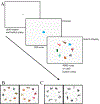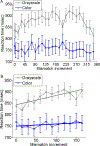Specifying the precision of guiding features for visual search
- PMID: 31219282
- PMCID: PMC6706321
- DOI: 10.1037/xhp0000668
Specifying the precision of guiding features for visual search
Abstract
Visual search is the task of finding things with uncertain locations. Despite decades of research, the features that guide visual search remain poorly specified, especially in realistic contexts. This study tested the role of two features-shape and orientation-both in the presence and absence of hue information. We conducted five experiments to describe preview-target mismatch effects, decreases in performance caused by differences between the image of the target as it appears in the preview and as it appears in the actual search display. These mismatch effects provide direct measures of feature importance, with larger performance decrements expected for more important features. Contrary to previous conclusions, our data suggest that shape and orientation only guide visual search when color is not available. By varying the probability of mismatch in each feature dimension, we also show that these patterns of feature guidance do not change with the probability that the previewed feature will be invalid. We conclude that the target representations used to guide visual search are much less precise than previously believed, with participants encoding and using color and little else. (PsycINFO Database Record (c) 2019 APA, all rights reserved).
Figures













